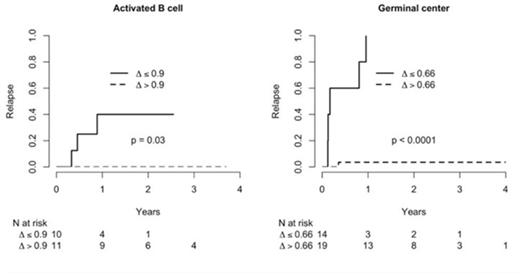Introduction:The role of interim positron emission tomography (PET) as a predictor for progression free survival (PFS) in patients with diffuse large B-cell lymphoma (DLBCL) remains controversial. The incorporation of volumetric and quantitative parameters aims to improve the identification of patients with high risk for treatment failure. Recently, the role of ΔSUVmax, defined as the reduction between the maximum uptake at initial PET and interim-PET (iPET) has been tested as a predictor for PFS. In most studies, a cutoff of 66% reduction successfully identified patients at high risk for treatment failure. We aimed to analyze the role of ΔSUVmax in predicting relapse in a cohort of Brazilian patients with DLBCL, and the impact of COO in this analysis.
Methods:We retrospectively analyzed a cohort of patients with DLBCL from Sao Paulo, Brazil. All diagnosis were made by the same hemepathologists, and COO was defined using Hans algorithm. PET scans were obtained at baseline and after 2-3 cycles (iPET) of CHOP-like chemoimmunotherapy. All PET-CTs were read by the same physician, blinded for COO and patient's clinical features. ΔSUVmax was calculated by the difference in % between initial PET SUVmax and iPET. Initially, a cutoff of 66% reduction was used for analysis, but due to low number of patients not achieving a 66% reduction in the activated B-cell (ABC) subgroup, the optimal cutoff was selected based on the ROC curve.
ResultsA total of 54 patients were available for analysis. Median age of all patients was 61 years old, and 61% of patients had a germinal center B-Cell (GCB) phenotype. The median maximum uptake at baseline was 31 for the germinal B-cell (GCB) and 34.1 for the activated B-Cell (ABC) phenotype. For all patients, ΔSUVmax <66 was strongly related to relapse (HR=0.065, p=0.0005). In the GCB cohort (n=33), ΔSUVmax <66 was also strongly related to relapse (H=0.02, p=0.0004). In the ABC cohort (n=21), only one patient failed to achieve ΔSUVmax>66. A ROC curve identified a ΔSUVmax>90 as a better cutoff for relapse, and patients not achieving 90% reduction had a higher risk for relapse (p=0.03). MYC/Bcl-2 expression was also compared, and ΔSUVmax <66 was related to events in both double-expressors (DE, p=0.0003) and in non-DE(p=0.036)
ConclusionA reduction <66% in SUVmax from baseline PET to iPET was strongly related to the risk of relapse in a cohort of 54 patients with DLBCL. However, the cutoff of 66% was only significant in patients with GCB DLBCL, mostly due to the low number of ABC patients who did not reach a 66% in SUVmax. For ABC patients, a ΔSUVmax>90 improved the identification of patients at high risk for relapse. Larger cohort of patients are needed to validate our exploratory findings.
No relevant conflicts of interest to declare.
Author notes
Asterisk with author names denotes non-ASH members.


